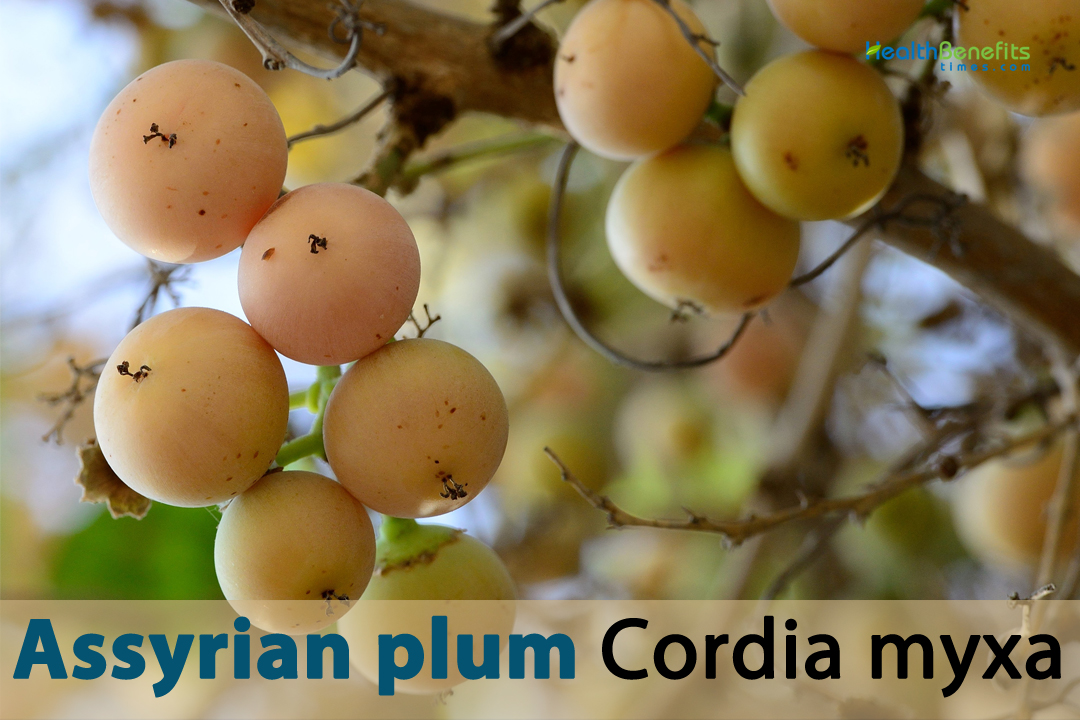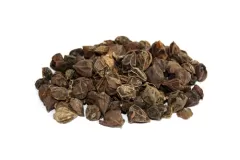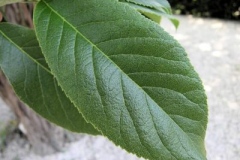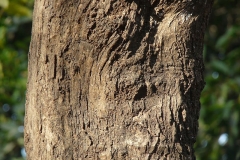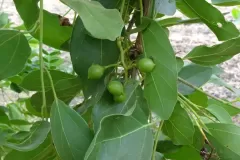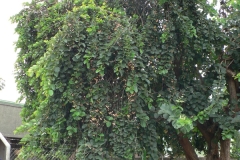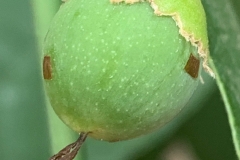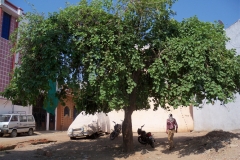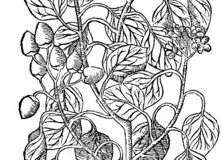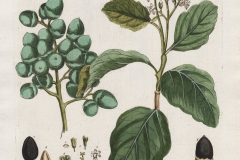| Assyrian plum Quick Facts | |
|---|---|
| Name: | Assyrian plum |
| Scientific Name: | Cordia myxa |
| Origin | Across tropical Africa and tropical Asia |
| Colors | Deep purple to dark blue skin when ripe |
| Shapes | Small to medium-sized drupes with a distinctive oval or round shape |
| Flesh colors | Pale yellow to golden orange |
| Taste | Sweet and mildly tangy |
| Major nutrients | • Vitamin C • Vitamin A • Fiber • Potassium • Antioxidants • Calcium • Iron • Phosphorus |
| Health benefits | Regulates Blood Pressure, Aids Sore Throat, Combats Skin Allergies, Eases Menstrual Pain and Toothache, Strengthens Body, heals Cough and respiratory issues, Liver healing Anti-ulcer benefits, Joint pain and arthritis, Impotence, Body heat, gain body weight, Hemorrhoids, Heart diseases and Stomach health |
| Name | Assyrian plum |
|---|---|
| Scientific Name | Cordia myxa |
| Native | Warmer areas across tropical Africa and tropical Asia including Iran, Pakistan, India, Sri Lanka, Bangladesh, Myanmar, Laos, Vietnam and more recently in the Americas |
| Common Names | Cherry plum, Cherry plumcot, European plum, Myrobalan cherry, Ornamental cherry plum, Cherry plum tree, Purple-leaf cherry plum, Bird cherry, Cherry plum hybrid, Myrobalan plum, Cherry-apricot plum, Wild plum, Indian-cherry, Sudan-teak, Clammy-cherry, Sapistan-tree, Glue berry, Sebastan-tree, Sebesten-plum, Assyrian-plum, Small cordia, Sapistan plum |
| Name in Other Languages | Afrikaans: Assiriese pruim Albanian: Qershi asiriane Arabic: Al-Barqūq al-Āshūrī (البرقوق الآشوري), Dálek, sibistan dubq (سبستان دبق) Armenian: Asori tsiran (Ասորի ծիրան) Assamese: Asiriyān ālubakhārā (এসিৰীয়ান আলুবখারা) Azerbaijani: Asuri ərik Bambara: Ntege Basque: Asiriako pruna Bengali: Aessirīẏān ālubakhārā (অ্যাসিরীয়ান আলুবখারা), Ba’ulā gācha (বউলা গাছ) Bislama: Assyrian plum Bulgarian: Asirska sliva (Асирска слива) Burmese: Thanat Catalan: Pruner assirià Chhattisgarhi: Asyurian plam (अस्यूरियन प्लम) Chinese: Yà shù lǐ (亚述李), Pò bù zi (破布子), Shù zi zǐ (樹子仔), Shù zi (樹 子), Máo yè pò bù mù (毛叶破布木) Croatian: Asirijska šljiva Czech: Asyrský švestka Danish: Assyriske blomme Dutch: Assyrische pruim English: Assyrian plum, Indian-cherry, Lasura, Sudan-teak, Clammy-cherry, Glueberry, Sapistan, Sapistan-tree, Sebastan-tree, Sebesten-plum, Selu, Small cordia, Sebesten, Lasoda, Sapistan plum, Sebesten plum, Fragrant Manjack, Bird lime tree, Cordia tree, Glueberry tree, Indian glue berry Esperanto: Asira pruno Estonian: Asüüria ploom Fijian: Assyrian plum Filipino: Prunong Asiryano Finnish: Assyrialainen luumu French: Prunier d’Assyrie, Bois savon, Sébestier, Sébestier dichotome Galician: Ameixeira assíria Georgian: Assyrian irchi (Assyrian ირჩი) German: Assyrische Pflaume, Assyrian Plum Greek: Assyriakó damaskinó (Ασσυριακό δαμασκηνό), Assyriakí damáskinο (Ασσυριακή δαμάσκηνο) Gujarati: Aśūriyana ālū (અશૂરીયન આલૂ), Gundā (ગુંદા) Haitian Creole: Prun asiryen Hausa: Ashiriyan jinya Hawaiian: Plumasiaina Hebrew: Shezif Ashuri (שזיף אשורי) Hindi: Assīriyan ālūbukhārā (अस्सीरियन आलूबुखारा), Assyrian plum, Gondi, Gondhi, Gunda, Lasurha, Tenti dela, बहुवार Hungarian: Asszír szilva Icelandic: Asýrskt plómubær Indonesian: Plum Asiria Irish: Prún Asarbhaiceach Italian: Prugna assira Japanese: Asshirian puramu (アッシリアンプラム) Javanese: Plum Assyrian Kannada: Aśyūriyan plam (ಅಶ್ಯೂರಿಯನ್ ಪ್ಲಮ್), Caḷḷe haṇṇu (ಚಳ್ಳೆ ಹಣ್ಣು) Kashmiri: Aīsirīa nāranja (ایسیریا نارینج) Kazakh: Assiriya shaqaldy (Ассирия шақалды) Konkani: (Asyurian plam (अस्युरियन प्लम्) Korean: Aswilria jadu (아쉬리아 자두) Kyrgyz: Assiriya ürökü (Ассирия үрөкү) Lao: Man, Sino-Tibetan, Man khok Latvian: Asīrijas plūme Lithuanian: Asirijos slyva Luxembourgish: Assyrësch Pflaum Macedonian: Asirska šljiva (Асирска шљива) Malagasy: Prûne Asira Malay: Plum Assyrian, Manonang, Nimang, Sekendai, Sekendal, Tomatangtang Malayalam: Assīriyaṉ plam (അസ്സീരിയൻ പ്ലം) Maltese: Slielem Asirjan Manipuri: Āssirīẏān ālubakhārā (আস্সিরিয়ান আলুবখারা) Maori: Prūmi Assyrian Mongolian: Asiri shalgas (Асири шалгас) Nepali: Asirian ālubakhadā (असिरियन आलुबखडा), Bohori, Lasura Norwegian: Assyriske plomme, Assyrisk plomme Odia: Assyrian plum Pashto: Ashurya naranj (آشوریا نارنج) Persian: Alvī Āshūrī (آلوی آشوری) Polish: Asyryjska śliwka Portuguese: Ameixeira assíria, Catuteiro, Córdia, Sebesteira, Sebesteiro-do-Sudão, ameixeira-da-assíria Punjabi: Asūriyān ālū (ਅਸੂਰੀਆਨ ਆਲੂ), Lasura Romanian: Prun asirian Russian: Assiriyskaya sliva (Ассирийская слива), Kordiia indijskaia (Кордиа индийская), Kordiia vil’chataia (Кордия вильчатая), cebesten (cебестен) Samoan: Plamu Asiria, Apu asiriā Sanskrit: Asyurian prūn (अस्युरियन प्रून्), Shelu, Bahuvarka, Shleshmatak Scottish Gaelic: Pluman Asarach Serbian: Asirijska šljiva Sindhi: Aīsīrī’ā’in palam (ایسییریائن پلم) Sinhala: Asiriyāna prom (අසිරියාන ප්රොම්) Slovak: Asýrska slivka Somali: Hambalyo asiriyaan Spanish: Ciruelo de Asiria Sumatran: Nunang Sundanese: Plum Assyrian Swahili: Plumu la Ashuri Swedish: Assyrisk plommon, Assyrian plommon Tagalog: Anonang, Anonang bakir, Anonung, Anunong, Saloyong Tahitian: Pīmā Ātirea Tajik: Assiri alu (Ассирӣ алу) Tamil: Acciriya paḻam (அச்சிரிய பழம்) Tatar: Assiriya alma (Ассирия алма) Telugu: Assairiyan plam (అస్సైరియన్ ప్లమ్) Thai: Phlam e chū riia (พลัมเอชูเรีย) Tok Pisin: Asirian plam Tongan: ʻOte asilaʻia Turkish: Asur eriği Turkmen: Assyrian almak Twi: Assyrian plum Uighur: Assiriye gül (ئاسسىرىيە گۈل) Urdu: Ashwariya ālu (اشوریہ آلو), Assyrian alu Bukhara (اشوریائی آلو بخارا), Sipistan Uzbek: Assiriya uruqi Vietnamese: Mận Assyrian, Tâm mộc nhớt Welsh: Eirin Assyriaidd Yoruba: Pupa Asiriya Zulu: I-asiriya impukane |
| Plant Growth Habit | Multipurpose, perennial, medium sized, broad-leaved, deciduous, evergreen shrub or tree |
| Growing Climates | Around villages, old abandoned habitations, dry deciduous woodland, temperate deciduous forests, orchards, farmlands, parks, residential yards, along streets, home gardens, riverbanks, riparian zones, foothill regions, woodland edges, forest clearings, and abandoned fields |
| Soil | Prefer loamy or sandy soil with good drainage to prevent waterlogging. The soil should also be rich in organic matter and have a slightly acidic to neutral pH level |
| Plant Size | Around 4 to 6 meters (13 to 20 feet) tall with a spread of about 3 to 4 meters (10 to 13 feet) wide when fully mature |
| Root | Typically has a shallow and spreading root system |
| Stem | Woody and branched stem |
| Bark | Grayish brown in color with longitudinal and vertical fissures |
| Leaf | Oval or elliptical, with a pointed tip and a rounded or slightly tapered base. They may measure around 5-10 cm long and 2-5 cm wide |
| Flowering season | Between April and June |
| Pollinators |
|
| Flower | Flower consists of several reproductive structures, including stamens and pistils |
| Fruit Shape & Size | Small to medium-sized drupes with a distinctive oval or round shape, typically measuring around 2 to 3 cm in length |
| Fruit Color | Deep purple to dark blue skin when ripe |
| Fruit skin | Smooth and thin, with a slightly waxy texture |
| Flesh | Juicy, tender, and sweet, with a pleasing balance of sweetness and tartness |
| Flesh Color | Pale yellow to golden orange |
| Seed | Oval or oblong shape with a pointed tip and a slightly flattened profile measuring around 1 to 2 cm in length |
| Flavor/Aroma | Sweet, fruity, and mildly floral |
| Taste | Sweet and mildly tangy |
| Plant Parts Used | Fruit, leaves, bark, roots |
| Propagation | By seeds, Semi-hardwood cuttings, Layering and Grafting |
| Lifespan | From 20 to 50 years or more under optimal conditions |
| Season | Around August to November |
| Major Nutrition |
|
| Health benefits |
|
| Available Forms |
|
Plant Description
The Assyrian plum is a versatile, medium-sized, perennial, deciduous, evergreen shrub or tree with broad leaves that has a dense crown. The bole is rigid and averted. At maturity, the plant typically attains a height of 4 to 6 meters (13 to 20 feet) and a width of 3 to 4 meters (10 to 13 feet). The flora inhabits a variety of environments, including dry deciduous woodland, abandoned habitations in the vicinity of villages, temperate deciduous forests, residential yards, streets, home gardens, riverbanks, riparian zones, foothill regions, woodland edges, forest clearings, and abandoned fields. To avoid waterlogging, the plant prefers loamy or granular soil with adequate drainage. Additionally, the soil ought to be organically dense and have a pH range of mildly acidic to neutral. It is a versatile, widely utilized tree that is frequently harvested from the wild for regional use as a material, sustenance, and medicine. For its medicinal and palatable properties, the tree has been cultivated since the time of the ancient Egyptians. It continues to be cultivated in many regions of the tropics and subtropics today. As an ornamental and avenue tree, it is also cultivated.
As with other plum varieties, Assyrian plums contain dietary fiber, vitamins, and minerals. In addition to antioxidants and vitamins A, C, and K, they also contain potassium. They are multipurpose fruits that can be preserved as jams, jellies, and sauces, ingested raw, dried, or processed. Additionally, they are frequently utilized in the preparation of delicacies like cobblers, pies, and plum tarts. In the regions where they are cultivated, Assyrian plums are culturally significant. Their prevalence in traditional dishes and festivities is indicative of their significance in regional gastronomy and traditions. The plant serves as a habitat and sustenance source for numerous species of wildlife, including insects and birds. Additionally, it contributes to erosion control and soil conservation in its native habitats.
Roots
Young Assyrian plum trees typically develop a primary taproot that extends in a vertical direction from the trunk base. As the tree reaches maturity, lateral roots that protrude horizontally from the base of the trunk may develop from the taproot. Fibrous roots, which are slender, branching roots that extend widely in the topsoil, are produced by Assyrian plum trees. Root hairs are minuscule, hair-like projections found on the outer surface of the fibrous and lateral roots.
Stem
The stem’s primary, vertical segment is referred to as the trunk. It supports the branches and foliage above the tree and functions as its central axis. From the trunk protrude branches that extend in diverse directions. In addition to bearing fruit, flowers, and leaves, these branches are essential for photosynthesis, reproduction, and fruit production. Young, delicate stems known as shoots originate from buds situated along the branches. They undergo elongation and produce fruit, flowers, and foliage throughout the growing season.
Vascular tissue, comprising xylem and phloem, facilitates the transportation of carbohydrates, water, and nutrients from the roots to the remainder of the tree from within the stem. From the roots upward, xylem transports water and minerals, whereas phloem delivers carbohydrates produced during photosynthesis to other areas of the tree. Annual growth rings may be discernible in the wood of mature stems. Each of these rings signifies a different year of development for the tree thus far.
Bark
The periderm, which comprises the outermost stratum of the epidermis, serves as a defensive barrier against pathogens, environmental stresses, and physical harm. It consists primarily of decaying cells, which undergo constant replacement and shedding as the tree develops. The cork cambium, a stratum of meristematic tissue situated beneath the outer bark, is accountable for the generation of nascent cells that proceed to integrate into the outer bark. The cork of the epidermis is composed of cells called cork cambium, which are responsible for producing cork. Subterranean to the cork layer is the secondary phloem, a vascular tissue that facilitates the transportation of organic nutrients, including carbohydrates and amino acids that are synthesized by the leaves via photosynthesis.
Leaves
In general, the leaves have an elliptical or oval shape, featuring a pointed apex and a convex or marginally tapered base. They may have a width of 2-5 centimeters (0.8-2 inches) and a length of 5-10 cm (2-4 inches). The leaf is leathery and smooth on the surface, with a faint sheen. Greener on the upper surface compared to the lower surface is possible. While leaf margins are typically serrated or toothed, certain cultivars may possess leaf margins that are smoother. Assyrian plum foliage is characterized by conspicuous veins extending from the leaf’s base to its apex. The leaf pigmentation exhibits variability from pale to dark green, contingent upon variables including tree age, exposure to sunlight, and general well-being.
Flowers
Clusters of flowers are produced along the branches, generally emerging prior to the emergence of the foliage in early spring. Inflorescences are clusters composed of numerous individual blooms. Stamens and pistils are two of the numerous reproductive structures that comprise each flower. The male reproductive organs, the stamens, are composed of pollen-producing anthers atop slender filaments. The female reproductive organ, the stigma, style, and ovary comprise the pistil.
Fruits
The drupes produced by the Assyrian plum tree are small to medium in size and have a distinct ovoid or round shape. On average, they have a length of approximately 2 to 3 cm (0.8 to 1.2 inches). When ripe, fruits typically possess a deep purple to dark blue outer epidermis. However, certain varieties may display color variations that span from reddish-purple to almost black. Additionally, the epidermis may have a whitish, dusty coating called “bloom.” Smooth and thin, the epidermis has a faintly waxy consistency. Juicy, delicate, and sweet, the flesh has an enticing equilibrium of tartness and sweetness. The coloration can vary considerably, spanning from translucent yellow to golden orange, contingent upon the particular variety.
Seeds
In comparison to the fruit, Assyrian plume seeds are comparatively sizable, measuring an average of 1 to 2 centimeters (0.4 to 0.8 inches) in length. Oval or oblong in form, they have a pointed apex and a profile that is marginally flattened. The woody and rigid seed coat serves to fortify the nucleus within. The texture of the plum may vary slightly from smooth to slightly furrowed, contingent upon the particular variety. While brown seeds are the predominant hue, slight variations in shade may manifest. With the maturation of the seed within the fruit, the hue may darken. The nutritious kernel is located within the tough outer layer of the seed. The texture of the kernel is silky and buttery, and it has a delicate, nutty taste.
Health benefits of Assyrian plum
The plant has some incredible health advantages that have been utilized in traditional medicine for thousands of years. Here is a list of those health benefits.
1. Regulates Blood Pressure
Globally, hypertension stands as the most prevalent medical condition. A 2016 study identified anti-hypertensive properties in the fruit. This fruit extract has the potential to reduce oxidative stress and regulate blood pressure.
Furthermore, investigations conducted on rabbits to assess the hypotensive impact of Assyrian plum mucilage demonstrated that its mucilage contains blood pressure-lowering properties, whether present in mature or unripe fruit.
2. Aids Sore Throat
Those suffering from a sore throat or phlegm may find it quite beneficial to consume a fruit decoction. Incorporate the fruit into a decoction by boiling it in water and consuming the resulting mixture. Furthermore, the tree’s bark can be effectively purified and consumed after being boiled in water. If you do develop a hoarse throat, this concoction has the potential to be extraordinarily effective in providing relief.
3. Anti-diabetic Properties
A diabetic can derive substantial benefits from consuming Assyrian plum. Certain components within it possess diuretic properties. The results of the study indicated that fruit and seed possess anti-diabetic properties. Although it may not produce the same physiological response as Metformin, it remains an exceptionally beneficial medication for individuals grappling with hyperglycemia.
4. Combats Skin Allergies
The seeds are exceptionally effective in the treatment of irritations such as ringworm, dermatitis, and pruritus. Achieving a uniform paste necessitates the meticulous grinding of the seeds. Subsequently, the affected region may be treated with the plaster. The medicinal properties of this fruit have been recognized in Ayurveda since antiquity, and this practice continues to this day.
5. Eases Menstrual Pain and Toothache
Menstruation is excruciatingly painful and causes mood fluctuations. A dose of Assyrian plum administered during this phase alleviates the pain. Use the bark to make a decoction, which is then consumed. It is important to note that ingesting this decoction once or twice during the course of one’s menstrual cycle will yield significantly required alleviation. Additionally, toothaches can be treated with a decoction made by simmering the bark of the tree in water. Rinse your mouth with this solution thereafter.
6. Strengthens Body
The fruits of the Assyrian plum are rich in carbohydrates, fiber, calcium, phosphorus, and iron, in addition to protein. For optimal bodily functioning, each of these nutrients is essential. The fruit is commonly consumed uncooked by individuals. Nonetheless, many individuals also enjoy it in its desiccated state. Numerous households prepare laddoos through the process of dehydrating the fruit and subsequently blending it with an assortment of supplementary components. Therefore, fruit provides adequate energy and fortifies the body, enabling one to maintain an active lifestyle throughout the day.
7. Anti-inflammatory properties
Joint issues such as pain and edema must be treated with a decoction made from camphor and the bark of the tree. Subsequently, the sore or inflamed area may be massaged with this decoction twice daily, in the morning and evening. Additionally, the bark can be effectively ground into a smooth substance that can be topically applied to the affected area. This may be of tremendous benefit to you.
8. Cough and respiratory issues
According to research published in the IOSR Journal of Pharmacy, Assyrian plum possesses anti-inflammatory properties that may alleviate respiratory congestion and cough. As a result of the mucilaginous nature of the fruit flesh, ingesting the fruit may provide cough relief. The fruit pulp, which is mucilaginous, contains plant sterol, which is extremely effective at alleviating cough. Additionally, the fruit can alleviate throat discomfort and sore throat. The fruit extract is utilized in Unani medicine to treat fever and respiratory symptoms.
9. Liver healing
Fruit possesses numerous liver-healing properties. A study conducted on rats and published in January 2007 in the Nigerian Journal of Natural Products and Medicine demonstrated that various substances can promote liver healing, including mucilage, oil, glycosides, flavonoids, sterols, saponins, terpenoids, alkaloids, phenolic acids, coumarins, tannins, resins, gums, and coumarins.
10. Anti-ulcer benefits
Additionally, this fruit’s anti-ulcer properties were investigated and published in the Internet Journal of Pharmacology in 2009. Rats were used to examine the effects of Assyrian plum fruit extract, which was found to contain essential elements that prevent gastric ulcers, according to research.
11. Joint pain and arthritis
Joint pain associated with arthritis can reportedly be alleviated through consistent ingestion of Assyrian plum. According to a published study, the analgesic properties of fruits and leaves can alleviate joint discomfort. Nevertheless, it does not entirely supplant the use of pharmaceuticals.
12. Impotence
Currently, sperm dilution and a deficiency of sperm cells are the leading causes of many men’s inability to conceive in women. Men who consistently consume the fruit of the Assyrian plum experience enhanced sperm quality, increased sperm cell count, eradication of infertility, and paved the way for the development of a healthy fetus.
13. Body heat
Maintaining a constant average body temperature is of the utmost importance. A number of individuals experience headaches and fatigue as a result of their bodies overheating rapidly during the summer. Eating cold fruits during intense summer heat will help your body calm down, eliminate fatigue, and stimulate your mind and body.
14. Stomach Worms
An overindulgence in chocolate and desserts by children, especially those under the age of 12, results in the development of gastric worms, which negatively impacts their health and causes physical and mental exhaustion. The most effective natural remedy for gastrointestinal worms is fruit. Regular feeding of these fruits to children will result in the destruction of the nematodes, which will subsequently be eliminated from the body via bowel movements.
15. To gain body weight
Modern medical standards dictate that an individual’s bodily weight should correspond with their height. A minority are underweight. Individuals who require rapid weight gain frequently consume Assyrian plum fruits. Its nutrient content contributes to weight gain.
16. Hemorrhoids
The disease is brought on by chronic constipation, excessive consumption of foods that raise body temperature, and exposure to high temperatures. A wide variety of hemorrhoids exist. Rapid healing of any form of hemorrhoid is possible with the consumption of an abundance of Assyrian plum fruits and pickles made from this fruit.
17. Heart diseases
The heart is one of the organs in the body that must remain in good condition. Consistent consumption of Assyrian plum is beneficial for the heart, which is in charge of supplying circulation to every part of the body. It is composed of omega-6 compounds that possess properties that strengthen the heart.
18. Stomach health, digestive power
The fruit of the Assyrian plum is exceptionally high in fiber. Those who consume a great deal of these fruits will therefore no longer experience chronic constipation. This fruit stimulates the production of digestive acids, which are essential for the process of food digestion in the stomach. Fruit is beneficial for the health and efficient movement of the intestines and aids in the treatment of intestinal diseases.
Traditional uses
- Fruit is consumed as a demulcent, to suppress cough, and to treat respiratory complaints and sore throats.
- The fruit pulp is administered topically to ringworm in Tanzania.
- Ivory Coast and Mali employ the leaves as a topical remedy for ulcers and lesions.
- A lotion formulated from a macerate of the leaves is utilized to treat trypanosomiasis and sting insect attacks.
- Powdered bark is applied to the skin of fractured bones in the Comoros prior to the application of plaster in an effort to promote healing.
- Bark powder is applied topically to address skin conditions, while bark liquid, when combined with coconut oil, is ingested for the treatment of colic.
- They are specifically employed for the management of thoracic discomfort, coughing, and abdominal discomfort.
- Mucilaginous and laxative, the fruit’s viscous substance is mucilaginous and demulcent.
- Considered beneficial for the treatment of coughs, sore throats, respiratory complaints, and urinary tract irritations, this substance possesses demulcent and mucilaginous properties.
- It is administered in higher dosages for the purpose of treating bilious complaints as a laxative.
- The fruit is also applied topically to facilitate abscess maturation, alleviate rheumatic pain, and treat ringworm with anti-parasitic properties as an emollient plaster.
- The bark juice is ingested as an internal remedy for fevers.
- It is administered in conjunction with coconut oil to alleviate colic.
- Bark powder is applied topically for the purpose of managing skin disorders.
- Headaches are alleviated by applying the liquid of the leaves to the forehead.
- The leaves are utilized to treat ulcers, incisions, and sores.
- The bark paste was applied to eruptive boils and spider stings as a treatment.
Culinary Uses
- Fresh Consumption: Fresh Assyrian plums are a delectable and nourishing lunch option. They are at their juiciest and have a sweet-tart flavor when mature.
- Jams and Jellies: Due to their inherently high pectin content, Assyrian plums are flawless for preserving in jams, jellies, and preserves. By reducing them with sugar and occasionally lemon juice, delectable condiments for sandwiches, pastries, and toast can be produced.
- Compotes and Sauces: Compotes and sauces can be prepared by simmering or cooking Assyrian plums in combination with sugar and seasonings. Whether served chilled or tepid, these are ideal complements to desserts like ice cream, yogurt, or cake.
- Pies and Tarts: Popular delicacies, Assyrian plum pies and tarts accentuate the fruit’s inherent sweetness and flavor. Plums may be prepared alone or in combination with other fruits, such as apples or berries, into pie or tart crusts after being sliced or chopped.
- Cobblers and Crisps: Plums from Assyria make for outstanding ingredients in cobblers, crumbles, and nibbles. For a delectable and comforting dessert, they may be adorned with a sweet biscuit or streusel topping and baked until they become golden brown and bubble.
- Preserved Plums: Plums from Assyria may be preserved via dehydrating or canning. Prunes, which are dried plums, are a favored and nourishing refreshment option. In contrast, canned plums offer the advantage of prolonged storage and adaptation to a variety of recipes.
- Chutneys and Relishes: Chutneys and relishes, which are delectable condiments with a harmonious balance of sweet, sour, and spicy flavors, may be prepared with Assyrian plums. These can be complemented with proteins, cheeses, or vegetarian fare to enhance the flavor profile.
- Beverages: Assyrian plums are suitable for use in smoothies, cocktails, and juices, among other beverages. Plum juice can be obtained through the pressing or processing of cooked plums, whereas plum puree can be utilized to enhance the flavor of smoothies or concoctions.
- Baking: Assyrian plums are suitable for use in smoothies, cocktails, and juices, among other beverages. Plum juice can be obtained through the pressing or processing of cooked plums, whereas plum puree can be utilized to enhance the flavor of smoothies or concoctions.
- Savory Dishes: Additionally, Assyrian plums can be incorporated into culinary preparations, including salsas, meat and poultry sauces, and salads. Their inherent tartness and richness enhance the complexity of dishes and pair well with savory flavors.
Different Uses
- Dye: As an all-natural dye for textiles and fabrics, Assyrian plum skins can be utilized in a deep purple or blue hue. A deep purple dye can be obtained through the process of boiling the skins in water; this dye can subsequently be utilized to impart color to fibers, fabrics, and various other materials.
- Wood: Plumb tree timber, including that of Assyrian plums, is suitable for a variety of woodworking applications. It is highly esteemed for its lustrous grain patterns and dense, firm consistency. Plum wood is frequently employed in the construction of cabinetry, furniture, turned objects, and decorative items.
- Landscaping: In landscaping, Assyrian plum trees are frequently planted for their aesthetic value. Popular options for home gardens, parks, and public spaces, these plants feature appealing blossoms, vibrant foliage, and colorful fruits.
- Wildlife Habitat: Plum trees furnish wildlife with essential sustenance and habitat. Birds that aid in seed dispersal are especially enamored of the fruit, including robins and cedar waxwings. Pollinators, including butterflies and bees, are also drawn to plum trees, which increases the biodiversity of ecosystems.
- Erosion Control: Particularly on slopes and hillsides, the extensive root systems of plum trees, including Assyrian plums, aid in stabilizing the soil and preventing erosion. By planting plum trees in areas prone to erosion, one can safeguard the environment and improve the condition of the soil.
- Traditional Crafts: Plum branches and stems are utilized in certain cultural contexts for the creation of traditional crafts, including wreath making, basket weaving, and decorative arrangements. The branches’ malleability renders them well-suited for the processes of weaving and crafting into a multitude of forms.
- Spiritual and Cultural Symbolism: Plums possess considerable cultural importance within numerous societies and are frequently linked to motifs of profusion, affluence, and revitalization. Plum trees are planted as symbols of good fortune and future favors in some cultures.
Side effects
- Allergic reactions: Potential allergens include Assyrian plum. An allergic reaction may manifest as pruritus, urticaria, edema, or edema. It is imperative that individuals who have consumed Assyrian plum and subsequently encounter these symptoms seek medical attention immediately.
- Gastrointestinal distress: Similar to numerous other fruits and vegetables, Assyrian plum is rich in fiber. Although fiber aids in digestion, overconsumption may result in abdominal distention, flatulence, and diarrhea. To facilitate systemic adaptation, it is recommended to incorporate Assyrian plum into one’s diet progressively.
- Blood sugar levels: Diabetes patients may experience an impact on their blood sugar levels when consuming Assyrian plum. Individuals diagnosed with diabetes are advised to monitor their blood sugar levels and seek guidance from their healthcare provider when necessary.
- Oxalate content: Assyrian plum is composed of oxalates, which are compounds that, in individuals who are susceptible, may contribute to the development of kidney stones. It may be necessary for individuals with a prior occurrence of kidney stones to restrict their consumption of oxalate-rich foods, such as Assyrian plum.
- Culinary considerations: When consumed raw, improperly prepared Assyrian plum may induce pruritus, which is characterized by pruritus of the mouth and pharynx. Properly processing or cooking Assyrian plum can assist in mitigating this issue.
References:
https://www.itis.gov/servlet/SingleRpt/SingleRpt?search_topic=TSN&search_value=565086#null
https://www.cabidigitallibrary.org/doi/10.1079/cabicompendium.15393
https://gd.eppo.int/taxon/CRHMY
https://identify.plantnet.org/k-world-flora/species/Cordia%20myxa%20L./data
https://en.wikipedia.org/wiki/Cordia_myxa
https://tropical.theferns.info/viewtropical.php?id=Cordia+myxa
https://indiabiodiversity.org/species/show/259345
https://plants.usda.gov/home/plantProfile?symbol=COMY
https://www.feedipedia.org/node/163


